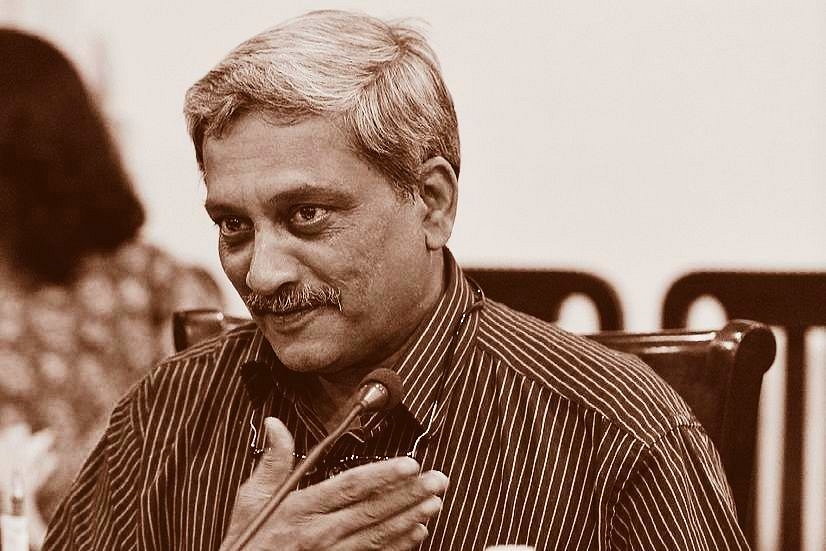Books
Book Excerpt: How An Agitation For A Ganesh Temple Led To One Of Manohar Parrikar's Earliest Organisational Wins
- A Congress minister in Goa was opposing the setting up of a Ganesh temple next to his house, and using force to have his way.
- It was then that Manohar Parrikar took up the cause.

Former Goa CM Late Manohar Parrikar (Ash Carter/Wikimedia Commons)
An Extraordinary Life: A Biography of Manohar Parrikar. Sadguru Patil and Mayabhushan Nagvenkar. Penguin eBury Press. 256 pages. Rs 439.
With Parrikar so well-entrenched into the RSS in Goa, it wasn’t a surprise when he enthusiastically plunged into the Ram Janmabhoomi campaign, which the Sangh’s political arm, the BJP, was spearheading.
Parrikar led two groups from Goa to Ayodhya in 1990 and again in December 1992. While the first group comprised eighty members, by the time Parrikar readied for his second outing, there were around 350 karsevaks waiting to be led to Ayodhya.
On one of the trips, security personnel lathi-charged towards that part of the crowd where the Goan contingent had gathered. There was chaos with people running in panic. Parrikar too had to bear the brunt of a lathi and was about to retaliate against the men in uniform, when his RSS contemporary from Goa, Shripad Naik, held him back.
Parrikar’s mother accompanied him on one of the two trips. Like all caring mothers, Radhabai had confided in her family members that the real reason she was making the trip to Ayodhya was to look after her son. She was worried sick about him. During a lathicharge on the group of karsevaks from Goa, who were sleeping at the Ayodhya junction railway station at around 2.30 a.m., everyone dispersed. The security personnel were trying to clear the railway station, but in the panic that ensued, Parrikar was separated from his mother in the dark. He eventually traced her after half an hour of looking around in anxiety.
Radhabai too was struck on her leg with a lathi for her efforts.
The swelling lasted for some time. So for several days until the swelling and the welt marks faded, she would show her wound to her neighbours and boast about the fact that she had braved a lathicharge at Ayodhya.
What Ayodhya and Lord Ram did to the political fortunes of BJP and L.K. Advani in north India, Ganeshpuri and Lord Ganesh did to the destinies of BJP and Manohar Parrikar in Goa.
In the early 1990s, Parrikar enacted his first full-fledged political act as a young BJP leader at the state housing board colony located atop a barren hillock in Mapusa. The colony was a relatively new one, with several plots waiting to be occupied.
One of the early residents of the colony was Ashok Naik Salgaokar, a minister in the incumbent Congress government. In a plot adjacent to Salgaokar’s bungalow was an area designated for religious events, where a public celebration of Ganesh Chaturthi was organized every year by a few occupants of the colony. Over time, a tin shed was erected on the plot and residents installed a framed photo of Lord Ganesh and started performing aartis every evening.
This is when the bickering began. Salgaokar objected to the daily prayers and efforts to build a ghumti (small temple). An attempt by the local residents to replace the framed photo with an idol of Lord Ganesh finally infuriated him. One night, police swooped on the site, confiscated the idol and took it to the local police station for safekeeping.
By morning, Datta Kholkar and seven others, who were a part of the group that had installed the idol, were detained. But the same evening, Parrikar galvanized a mob of 300 BJP workers and after a few fiery speeches, stormed the Mapusa police station and forced the police to release Kholkar and the rest on a personal bond. A lathicharge also had to be ordered to disperse the mob. Later, the crowd converged once again at the proposed temple site at Ganeshpuri and conducted a mahaarti as an act of defiance.
Perhaps, for Parrikar, who was fresh from his Ayodhya sojourns, the small temple, which the protesters and he were fighting for, was the Mapusa equivalent of the Ram Mandir. And Salgaokar, whose spectre was ominously arching over the ghumti, was a flesh-and-bones variant of the Babri dome. Like the dome, Salgaokar’s political career too spectacularly crashed by the time the Ganeshpuri temple movement died down.
‘In Mapusa, Parrikar became a social hero because of the Ganeshpuri temple agitation, which he led . . . His leadership qualities came to the fore,’ Kholkar said.
Support Swarajya's 50 Ground Reports Project & Sponsor A Story
Every general election Swarajya does a 50 ground reports project.
Aimed only at serious readers and those who appreciate the nuances of political undercurrents, the project provides a sense of India's electoral landscape. As you know, these reports are produced after considerable investment of travel, time and effort on the ground.
This time too we've kicked off the project in style and have covered over 30 constituencies already. If you're someone who appreciates such work and have enjoyed our coverage please consider sponsoring a ground report for just Rs 2999 to Rs 19,999 - it goes a long way in helping us produce more quality reportage.
You can also back this project by becoming a subscriber for as little as Rs 999 - so do click on this links and choose a plan that suits you and back us.
Click below to contribute.
Latest